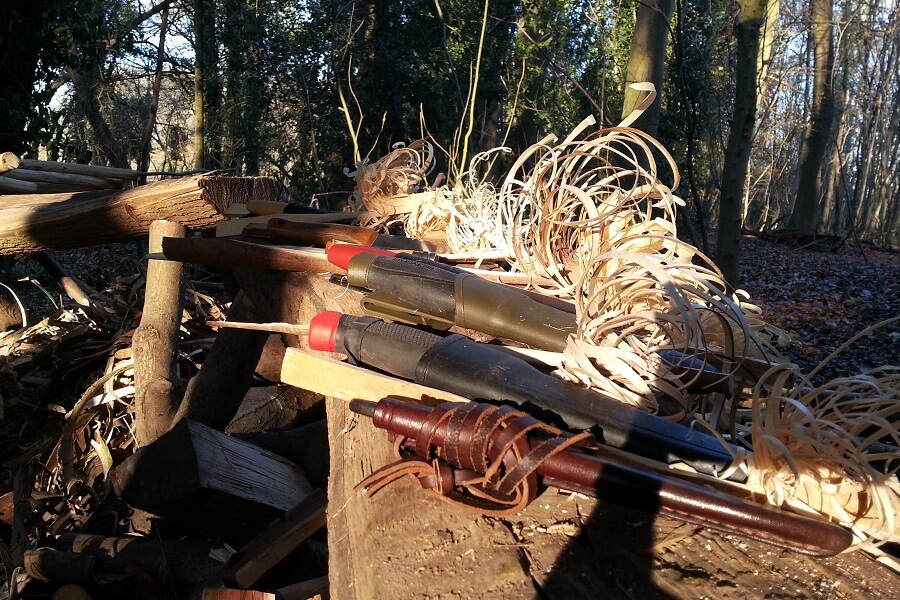Arguably the most useful useful piece of equipment to have when living outdoors is a knife. Sure you can improvise, perhaps using a piece of flint, having first knapped it into shape, but from a practical point of view a good knife is an essential.
There is much debate about what makes for a good knife and there are as many opinions as there are knives available, probably more! So having taken a pragmatic view on a selection of knives, the aim is to consider their merits of each for creating feather sticks – a stick that has been finely sliced to create curls of wood used for lighting a campfire (examples of curly feather sticks below).
Mora Classic No 1 Knife
The Mora Classic No 1 has been used for decades for wood carving, as a general purpose knife and by many bushcrafter’s. It has a carbon steel blade with a single bevel, both of which lend them selves to easy maintenance and sharpening. For those that like to wear a knife around their neck rather than on a belt, this is ideal as it weighs just 76 grams!
This is a lovely slim and lightweight knife, though at first it being so lightweight was a little strange, but it took very little time to enjoy slicing curly sticks. It has a red lacquered handle and whilst the colour is nice, I found the lacquer a little too thick, the result being that it felt a little slippery when gripped. I will probably lightly abrade the lacquer with fine grade sand paper to create a more positive feel when holding the knife.
This Mora Classic was wonderful for carving the curls on feather sticks – so much so, I can easily see why this is such a long standing classic knife, my only disappointment, perhaps, is that I didn’t start using one years ago.
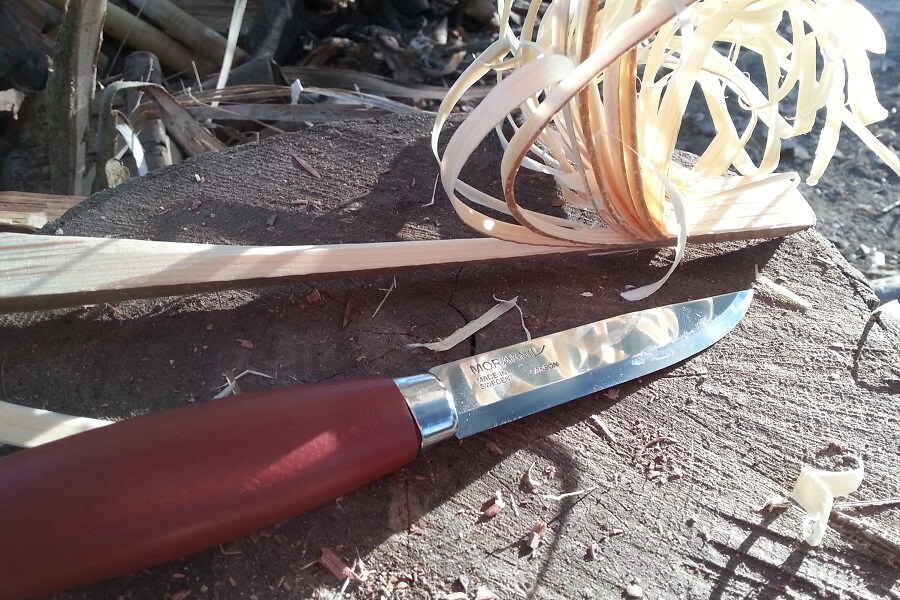
Traditional Bushcraft Knife
Here is an example of the traditional Bushcraft knife, it’s design establish by Ray Mears (world renowned authority on the subject of Bushcraft and Survival) and used by many Bushcrafter’s. I’ve been using this knife for some 10 years, the blade was made by Steve Wade Cox (maker of beautiful knives) and the handle and sheath made by me, it was a very enjoyable project! Steve Wade Cox also makes the Ray Mears Bushcraft Knife.
This a very solid knife, with a 4mm carbon steel blade, it’s relatively heavy coming in at 325 grams. But whilst it might be on the heavy side, it is fabulous for the Bushcraft duties it was designed for; everything from splitting wood, making camp gadgets through to craft work. It is a full-tang knife, meaning the steel goes through the whole length of the knife including the handle – this makes it a stronger knife that can take heavy use!
One of the benefits of the thicker blade is that it helps to make tighter curls. The wider blade pushes the slice of wood away and encourages it to curl – it’s this same characteristic that benefits wood splitting. You can perhaps see below, that the curls are smaller and tighter than those in some of the other pictures. This doesn’t mean to say they are necessarily better, just different!
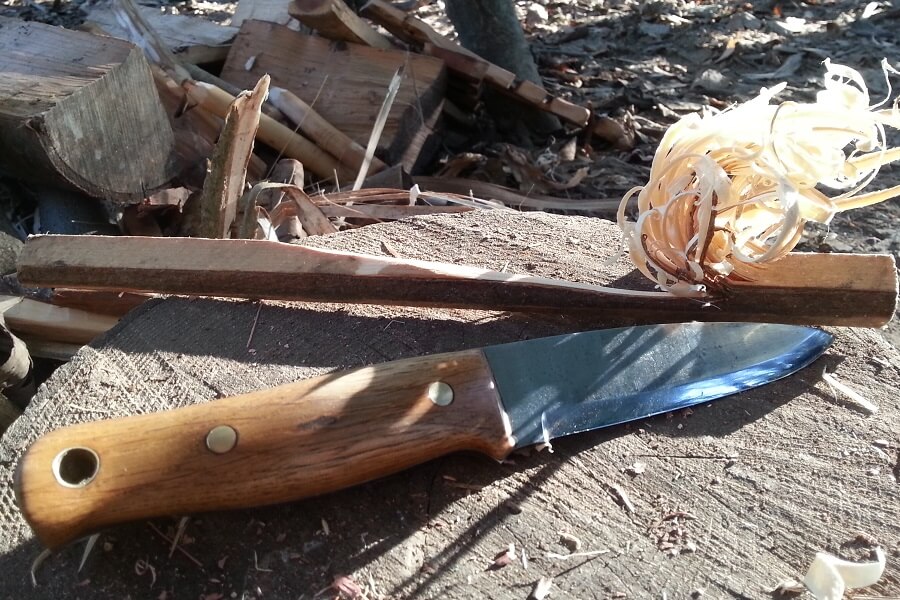
Mora Companion Heavy Duty Knife
Mora (Morakniv) make a wide range of knives and many of them have the now classic ‘skandi’ single bevel, which does make knife sharpening easier than most other designs. This is the heavy duty version of the Companion knife – it has a thicker blade than the standard Companion knife.
It is a nice knife to hold, with a very positive, tactile grip that made carving curls very easy. The slighter thicker blade, as with the traditional Bushcraft knife, appears to help form tighter curls. It being a more robust knife means it is also good for heavy duty tasks like splitting wood (as the name implies). At 135 grams it’s a comparatively lightweight knife, but has a bigger tang than some other models from Mora, so it’s up for some tough tasks!

Viking ‘replica’ knife
A Viking replica knife, what’s this knife doing in here? No, I’m not suggesting this is a general purpose Bushcraft knife, but it’s nice to through in a curve-ball for comparison! This is a lovely neck knife made by the esteemed British blacksmith Andrew Kirkham.
If you’d like to see and purchase some of Andrew’s lovely knives and axes, you’ll need to search him out at events such as the The Wilderness Gathering and The Bushcraft Show or you can buy his steel strikers directly from Beaver Bushcraft or crook knives, campfire tripods, and other items from Ray Mears.
Perhaps surprisingly, this really is a lovely knife both to look at and to use! Getting used to holding a knife with little in the way of a handle is a strange at first. It is obviously quite narrow, but it does mean you gain feedback, you feel the knife cutting through the wood. You might not want to be using such a knife for lots of carving, but it is a nice experience to use on small tasks.
The knife has a fine blade with a small secondary bevel and is razor sharp! Cutting the curls was an easy task, though they didn’t curl that much compared with some of the other knives. This maybe due to the narrowness of the blade – that said it did a fine job of creating feather sticks!
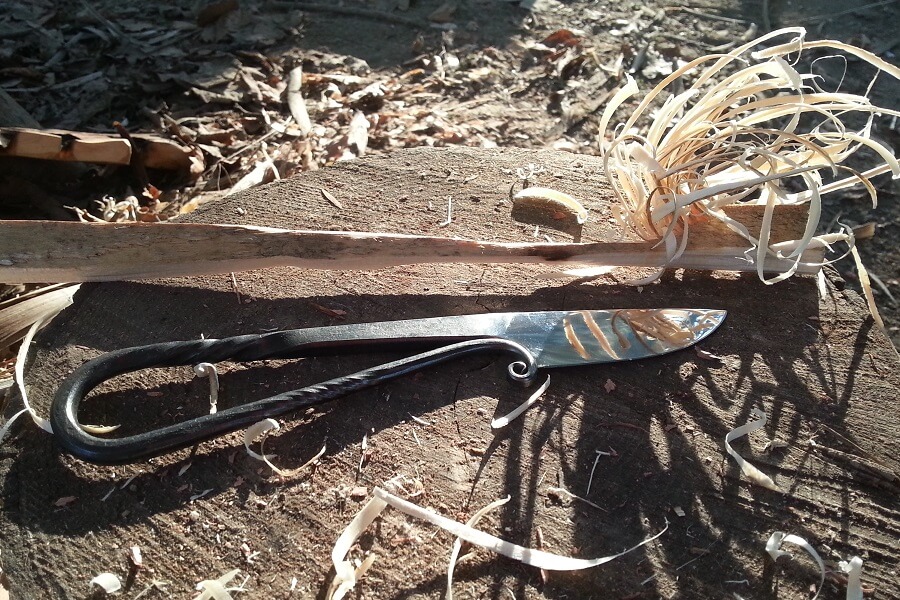
Mora 120 Erik Frost Craft Knife
This is a lovely little craft knife, it’s similar in design to the classic No 1 (above), but obviously with a much shorter blade and a little more pointy. The other notable difference is the birch handle that has just been oiled rather than a lacquered finish, this provides a positive grip.
The Mora 120 Erik Frost is designed for craft use, you certainly wouldn’t go using it to split wood. But as a tool to create lovely curls on your feather sticks it’s very, very good, and a pleasure to use! Those long curls, as you can see in the picture, were easy to produce – a great little knife.
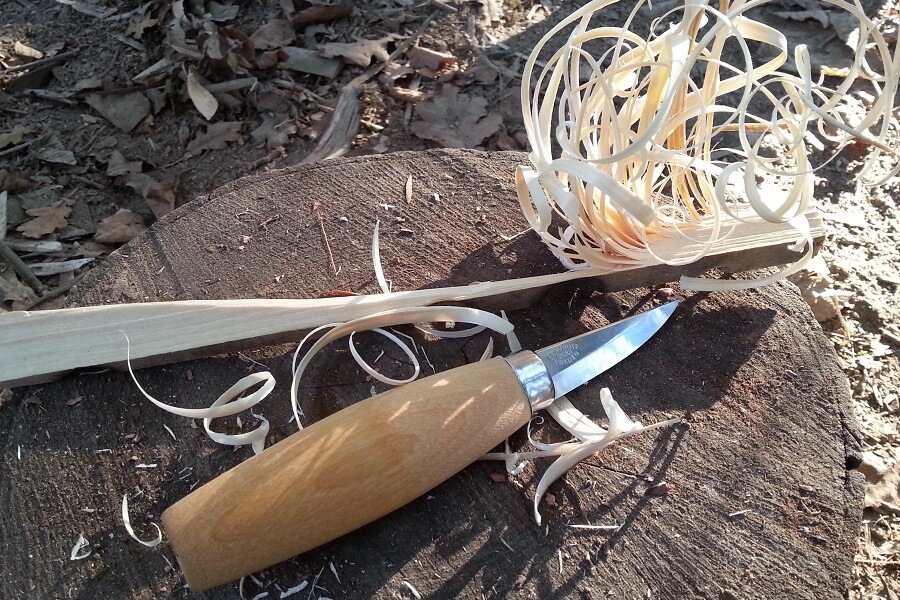
Opinel Pocket Knife No 7
The only folding knife I used for this comparison, the Opinel Pocket Knife No. 7, proved it’s worth. It is a tiny knife, and for some the narrowness may be an issue. I have one for use by those with smaller hands! Whilst a folding blade may result in the blade unintentionally folding onto users fingers, as can be the case for the ‘UK legal carry’ variants of the ‘Swiss Army Knife’, this Opinal does have a positive locking ring to lock the blade in position; either ready for use or locked into the handle.
This little knife did a fine job of creating a feather stick, but as you can see in the picture below, they didn’t really curl. I think this is in the main due to the narrowness of the blade. It may be that with a different approach to carving, curls could be produced, but lots of thins feathers were produced, so there would be little problem lighting a fire with the resultant feather sticks.
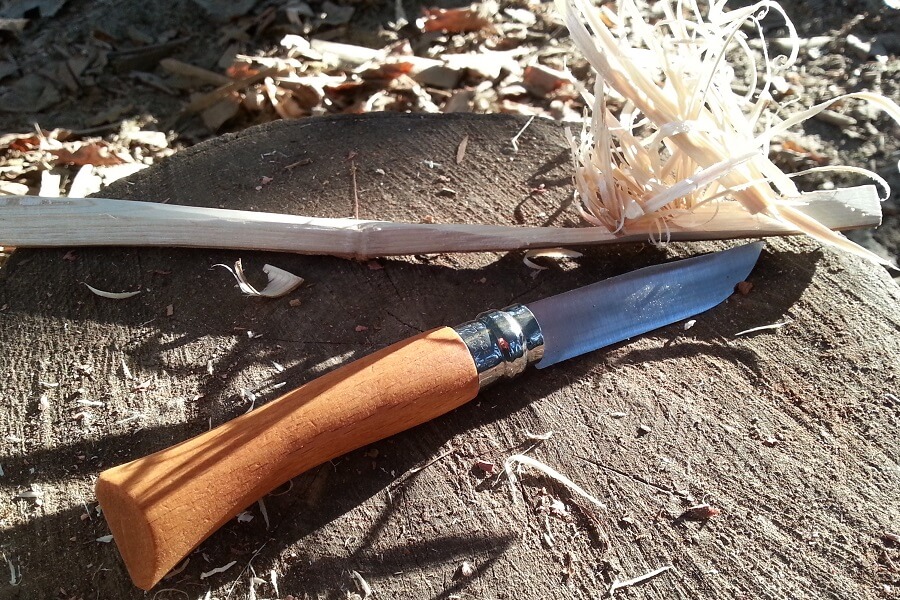
Frosts Mora Knife
I’ve been using this Frosts knife for around 15 years, a forerunner of the modern Mora knives, the depth of the blade is a little less due to it’s years of use and sharpening! I probably use this knife more than any other, it’s lightweight (105 grams), has a comfortable, all be it basic grip, it’s easy to sharpen due to the single bevel and carbon blade.
As you can see it created some lovely curls on the feather stick and interestingly the blade is quite narrow at just 2mm thick, so I think that the width of the bevel clearly made a difference. The nearest Mora to this model is probably the standard Companion knife and if it lasts as long as this knife will provide excellent value!
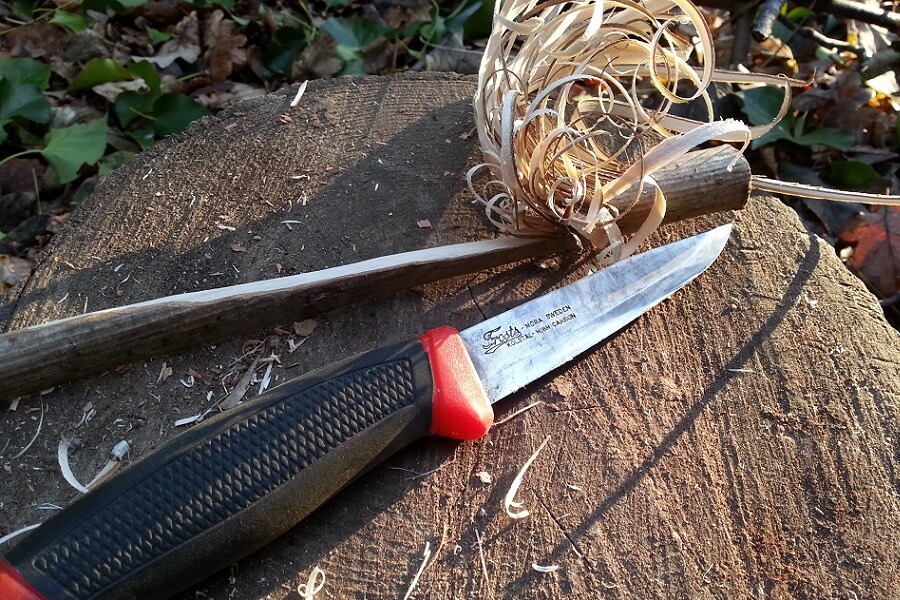
Conclusion
The feather sticks were created in the main using soft, straight grained pine, with the exception of the last using the Frosts, where (for those who may have noticed) a piece of hazel was used. So no, this is not a scientific approach to evaluation, but a pragmatic look at a few knives and how well they performed when creating feather sticks!
Was there a clear winner you may ask? Well that rather depends on what you want from your feather sticks…
Would you be able to light a fire with the feather sticks created?
All these knives delivered feather sticks, so whilst some may be more curly than others, you would undoubtedly be able to light a fire using any of the feather sticks produced by these knives.
Were the feather sticks curly?
If you’d like curly feather sticks, they will be a little better for lighting a campfire and look nicer too, then all of the Mora’s and the traditional Bushcraft knife are the clear winners. The Erik Frost would be ideal if you want to create flowers or darts with those feather sticks!
Is there an overall winner?
Well, not really. I think this ‘experiment’ showed that with a sharp knife and some straight grained softwood you can easily create some feather sticks. If pushed, I like my trusty old Frosts the most, and the nearest to that today would appear to be the Mora Companion. A very close second would be the Mora Classic, especially if you like the idea of a neck knife. As to whether to go for the heavy duty or standard version of the Companion, the standard will probably be better as a general purpose knife, especially for food preparation where a thinner blade is better (take a look at you kitchen knives to see why) and for finer carving. If you’re not that worried about finer carving or food preparations, the Heavy Duty will be a fine knife to use.
Do you agree? What are your experiences of these or other knives, especially for feather sticks?
